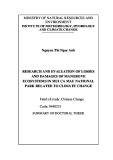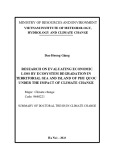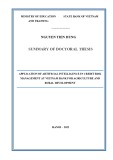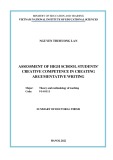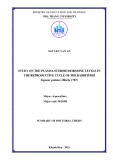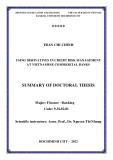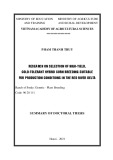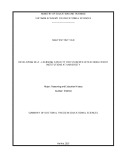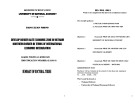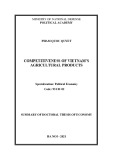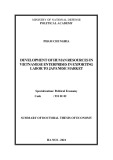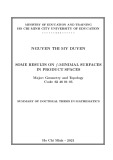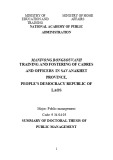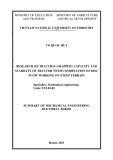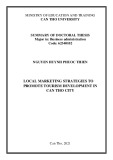1
MINISTRY OF EDUCATION MINISTRY OF DEFENCE AND TRAINING
MILITARY MEDICAL UNIVERSITY
NGUYEN TIEN DZUNG
STUDYING SOME CHARACTERISTICS OF CHONIC
WOUND AND EFFICIENCY OF AUTOLOGOUS
ADIPOSE TISSUE DERIVED STEM CELLS
TRANSPLANTATION
Specilty: BURNS
Code: 62.72.01.28
SUMMARY OF DOCTORAL THESIS
2
HA NOI 2018
3
THIS THESIS HAD FINISHED AT THE MILITARY
MEDICAL UNIVERSITY
Instructors:
1. Ass.Prof. PhD. Đinh Van Han 2. Ass.Prof. PhD. Quan Hoang Lam
Reviewer 1: Prof.PHD. DO Trung Phan
Reviewer 2: Prof.PHD. NGUYEN Manh Khanh
Reviewer 3: Prof.PHD. NGUYEN The Hoang
I’am presenting this thesis before the judge’s council of Military
Medical University at / / 2018
This thesis is available at:
National library
Library of Military Medical University
1
INSTRODUCTION
Chronic wound (CW) include, but are not limited, to diabetic
foot ulcers, venous leg ulcers, and pressure ulcers. They are a
challenge to wound care professionals and consume a great deal of
healthcare resources around the globe. This review discusses the
pathophysiology of complex CW and the means and modalities
currently available to achieve healing in such patients. Underlying
pathologies, which result in the failure of these wounds to heal, differ
among various types of CW. A better understanding of the
differences between various types of CW at the molecular and
cellular levels should improve our treatment approaches, leading to
better healing rates, and facilitate the development of new more
effective therapies.
Recently, stem cell therapy has emerged as a new approach
to accelerate wound healing. Adiposederived stem cells (ASCs) hold
great promise for wound healing, because they are multipotential
stem cells capable of differentiation into various cell lineages and
secretion of angiogenic growth factors
At the National Institute of Burns, cell therapy (such as fibroblast sheet, fibroblast secretion) was applied for burns treatment.
However, autologous adipose tissue derived stem cells
transplantation in CW treatment has never been studied. That is cause
we conducted this thesis, which has two subjects as follows:
1. Describing some clinical and paraclinical characteristics
and histology of chronic wound
2. Evaluating the effective of autologous adipose tissue
derived stem cell transplation in chronic wound treatment.
* The new contents of thesis:
2
CW are a challenge to wound care professionals. This study had
provided a detail clinical and paraclinical signs, CW are rich in
characteristics and difficult to treat. With the use of modern research
facilities, this topic has set the subject of research and provided a
detailed, detailed clinical profile of the CW characteristics,
pathological lesions in the lesion, wound healing, pH and CW
surface lesions, structural image and CW superstructure . In addition,
the topic of the study was the effect of stem cell transplantation from
adipose tissue on clinical presentation and structural morphology and
CW superstructure. By transplanting ADSC into CW, ADSC
stimulate the regeneration of extracellular matrix, as well as
stimulating proliferation, epithelial cell migration and new blood
vessel formation at the site of CW. * The layout of thesis: This thesis has 126 pages (not including references): Introduction (2 pages), chapter 1. Overview (31 pages),
chapter 2. Patients and medthods (14 pages), chapter 3. Results (40
pages), chapter 4. Discussion (35 pages), conclution (2 pages) and
recommendation (1 page). This thesis has also 22 tables, 7 figues,
50 images and 148 documents in reference (10 vietnames
documents and 138 english documents).
CHAPTER 1: OVERVIEW
1.1 Some CW characteristics CW are those that last for more than 6 weeks and relapse. Common
CW are ulcers caused by vascular disease (including arterial, venous
and lymphatic diseases), ulcers from diabetes, and ulcers. Although
there is a difference in origin at the molecular level, CW have
3
common traits: excessive proinflammatory cytokines and enzymes
that break down proteins, cells in the CW site age , persistent
infection and deficiency of stem cells (usually due to these
dysfunctional cells). In acute wounds, enzymes that break down
proteins and inhibitors are balanced. But for CW this loss of balance.
Proteindegrading enzymes are higher than those that inhibit it. In
CW, hypoxia predominates, which damages the proteins in the
extracellular environment and causes cell damage. In addition, CW
are characterized by the accumulation of aging cell populations,
which decrease in proliferation and migration, not responding to the
stimulation of wound healing. In addition to aging fibroblasts, CW
also include horn cells, endothelial cells, and aging, dysfunctional
macromolecules.
1.2. Stem cells and adipose tissue derived stem cell transplation
in CW treatment 1.2.1. Some stem cells in wound healing 1.2.1.1. Mesenchymal stem cells treat wounds: Mesenchymal stem cells are a type of multicentre, derived from mesenchymal stem cells,
found in many different tissues of the body such as blood, umbilical
cord, fatty tissue, bone marrow, pulp, muscle. and skin. Their multi
potential nature allows them to easily differentiate into different cell
types such as horn cells, epithelial cells, bone cells, cartilage, adipose
tissue, tendons and muscle cells. All three stages of wound healing
are inflammation, proliferation, and scarring. 1.2.1.2. Epithelial stem cells: Epithelial stem cells are usually found
in the epidermis, hair follicles and sebaceous glands. In the hair
follicle there are two populations of epithelial stem cells located in
the hair follicles, under the bulge and located just at the bulge of the
4
hair follicle. These stem cells are activated at the beginning of the
hair growth cycle and when injured to provide cells to repair and
repair the hair follicles and epidermis.
1.2.1.3. The endothelial progenitor cells: Endothelial progenitor cells
can be isolated from peripheral blood or bone marrow. Vascular
endothelial growth factors, granulocyte colonystimulating factors
and tissuederived factors are the most important factors contributing
to angiogenesis and mobilization of endothelial stem cells involved
in the process. new blood vessels in the wound process.
1.2.2. Adipose tissue derived stem cell transplation in CW treatment 1.2.2.1. Some characteristics of Adipose tissue derived stem cell: In 2001, Zuk PA and colleagues isolated the cells as stem cells in
adipose tissue. These cells can differentiate into different cells.
According to Meliga E et al. (2007), fatty tissue can be obtained in
large numbers in different parts of the body. On average, every 100
ml of fat tissue can isolate 106 ADSC have fibroblasts, with
intracellular development, large nuclei. ADSC have the same
immunity pattern as the mesenchymal stem cells isolated from bone
marrow, skeletal muscle. Over 80% of the fatty acid pattern of the
stem celllike mesenchyma is expressed by surface antibodies.
1.2.2.2. Adipose tissue derived stem cell transplation in CW treatment: Most studies now suggest that ADSC is involved in the wound repair process by differentiating into the tissue of the tissue at
the wound site. ADSC secrete some soluble elements. These are growth factors and cytokines that affect wound healing, such as EGF,
β β FGF , IGF, PDGF, TGF and VEGF. ADSC also participates in
immune regulation through the secretion of growth factors,
proinflammatory cytokines and antiinflammatory drugs such as IL
5
α β 6, IL8, IL12, TNF , IL10, HGF and TGF. ... In addition
ADSC also has the ability to promote macrophage transduction from
phenotypes M0 and M1 (causing inflammation at the site of CW)
into M2 (inflammatory) ). During proliferation, ADSC has a positive
effect by stimulating the formation of new vascular protuberances.
ADSC also stimulates proliferation and increases the ability of
fibroblasts to migrate through the secretion of growth factors such as
β FGF , EGF, and PDGFAA. ADSC also promotes epithelial
regeneration, thanks to the secretion of cytokines such as KGF1 and
PDGFBB. At the stage of scarring, ADSC is said to have a positive
effect to reduce scar size, improve the color of scar, reduce the rate of
keloids, scissors scissors. Thanks to the ability to stimulate the
activity of enzymedegrading enzymes MMPs.
In wound healing, ADSC can be injected directly into the wound
area, injected onto the wound surface, or placed on the ADSC surface
and then applied to the wound surface.
1.3. Some studies in Viet Nam A number of ADSC applications in treatment of various therapies
such as "Study on the use of stem cell derived stem cells from
adipose tissue and bone marrow for the treatment of chronic
obstructive pulmonary disease" is being conducted at Bach Mai
Hospital according to Decision No. 949 / QDBKHCN dated 25
April 2016. Topic: "Test for treatment of degenerative diseases of
knee joint by stemcell transplantation from fatty tissue and plasma Plutoconazole is extracted with Kit Extracttion and PRP Pro "is being
performed at the hospital of the University of Medicine and
Pharmacy, Ho Chi Minh City. In 2012, at the National Burn Institute,
the topic: "Research on the process of fat cell stem cell extraction and
6
bioproduct testing for wound healing, burns", this is a potential topic
in the chapter. KC10 has been developed and accepted. The research
team of the project successfully isolated the ADSC, identified the
characteristics of the ADSC, successfully fabricated the ADSC.
Continuing the results of the KC10 project, in 2014 the Ministry of
Health approved the National Institute of Burns to carry out the
project "Research on the development of mesenchymal stem cell
transplantation from chronic fat tissue ", The subject will be accepted
in the fourth quarter of 2017. In 2016, the Department of Science and
Technology of Hanoi approved for the Institute of Burns
implementation of the topic:" Study of treatment of longlasting
ulcers with platelet rich plasma in combination with adipose tissue
stem cells, "which will be tested in the fourth quarter of 2017.
CHAPTER 2. PATIENTS AND METHODE
2.1. Patients:
Patients were alduls over the age of 16 with CW,
addmissiion of Department of Wound Healing, NIB, from October
2014 to June 2016.
Exclusion: Patients with radiation ulcers or cancer ulcer.
Patients with HIV, HbsAg, HCV positive.
2.2. Methode 2.2.1. Studying design: For objective 1: We accomplish this by the crosssectional
descriptive research method.
7
For objective 2: In order to determine the efficacy of ADSC in CW
management, we conducted a comparative research approach.
2.2.2. Number of patients studied For Objective 1: Apply the formula to calculate the sample size to
estimate a proportion of the descriptive study to characterize the
clinical characteristics of patients with CW. We randomly
selected 56 patients for this purpose.
For Objective 2: Apply the formula to calculate the therapeutic
effect of a solution (in this study, the solution is to use the ADSC
itself). We randomly selected 30 patients in 56 patients in Objective
1 to achieve Objective 2.
2.2.3. Methodes for studying clinical characteristics Timelines:
T0: During the first 72 hours of hospitalization
T1: is the time immediately before the ADSC
T2: is the seventh day from the date of ADSC transplant
T3: is the 15th day from the date of ADSC transplant
T4: is the 20th day from the date of ADSC transplant.
For Objective 1: To determine the clinical and laboratory
characteristics at T0.
For Objective 2: Identify clinical and laboratory characteristics at
T1, T2, T3 and T4.
2.2.4. Studying the clinical characteristics
o Identify criteria such as age, sex, history of disease, pathologies that cause CW or indirect impact on the wound. Duration
of wounds, number of wounds and location of each wound.
8
o Periwound skin: Determination of acute inflammation, epithelialisation, wound healing, scarring of the wound edges,
moisture and temperature of the affected skin.
o CW surface: Determination of wound size, wound depth, tissue properties, serum pH, wound surface pH. o Adipose tissue derived stem cell transplation: Indication: CW has the following conditions:
Necrotic wound, no bone, tendon.
The wounds show no clinical signs of infection.
The wound does not have a tunnel, a frog's jaw.
In place of CW, clean wounds and healthy skin around the wound
with 4% Clohexidine solution. Then rinse with 0.9% sterile solution
of Natriclorid. Soak the wound with sterile gauze. Spreading aseptic.
Cut the ADSC sheet from the transwell, flip the ADSC face towards
the wound surface, gently insert the ADSC sheet itself onto the
wound surface, so that the cell sheet covers the entire wound surface,
the ADSC sheet overlapping each other. Place sterile Vaselin gauze
and 6 sterile gauze patches on the ADSC sheet, then bandage the
wound with a bandage or bandage Urgocrèpe.
2.2.5. Studying the paraclinical characterictics At the time of study T0, T1, T2 T3 and T4 conducted:
Determination of peripheral blood biochemical markers:
Number of red blood cells, hemoglobin, white blood cells, protein,
albumin and liver enzymes: SGOT, SGPT. CW surface imaging: Identification and quantify cation of
bacteria / cm2.
Determination of structural change on H & E staining and
wound stain on transfer electron microscope.
9
2.3. Data analysis: Statistical analysis and processing using Intercool Stata 12.0 software.
CHAPTER 3. RESULTS
3.1. Some clinical and paraclinical characteristics of CW
3.1.1. General characteristics Table 3.1 and chart 3.1: 56 patients had 71 CW, the average age was 52.96 ± 18.19 (1988 years old). Male/ female ratio was 1.67. 94.64% patients had comorbidities (the first was cord injury
(37.5%). The second was heartrelated diseases and diabetes mellitus
(9.64%). The CW were usually pressure ulcer (49.30%), soft tissue
infection (29.58%), diabetic ulcer/ trauma wounds (7.04%).
3.1.2 Clinical chracteristics of CW 3.1.2.1. General cheracteristics Chart 3.2+ Table 3.2 + 3.3: CW observed usually at lower extremities (43,66%), pilonidal area (39,44%), trochanter area
(5,63%). 14.29% patients had 2 CW, 7.15% patients had more than 3
CW. Almos CW hadn’t acute inflammative signs (76.06%).
3.1.2.2. Characteristics of periwound skin Table 3.4 +3.5 +3.6: Characteristics of periwound skin
Characteristics
Fibrotic Wounds 53 % 74.65
Hyperkeratosis 48 67.61
Moist at periwound skin 18 25.35
Dry at periwound skin 23 32.39
Without epithelialization 64 90.14
Temperature was lower 42 59.15
than normal skin area
10
Comment: At the periwound skin of CW usually manifests fibrotic, tempreture and without lower hyperkeratosis moist/dry,
epithelialization.
3.1.2.3. Clinical characteristics Table 3.7+ 3.8: Average size of chronic wouds was 25.71 cm2. 56.34% of CW size was lower than 20 cm2. 90.14% of CW were the third degree. Table 3.7+ 3.8: Tissue and exudate of CW:
Characteristics Oedema of granulation Wound 19 % 26.76
Epithelial tissue 3 4.23
Necrosis 8 11.27
Soft tissue under skin 27 38.03
Large amount of exudate 47 66.20
Milky exudate 40 56.34
Alkaline pH 68 95.77
Comment: CW were characterized by full thickness wounds, oedema granulation, necrosis, large amount of exudate and alkaline pH on
wound surface.
P.aeruginosa S.aureus (33.96%),
3.1.3. Paraclinical characteristics at T0 3.1.3.1 Infection on CW surface Table 3.11 + 3.12: 77.36% of CW were positive bacteria. Common bacteria were (13.21%), K.pneumonia and Aci.baumanii (5.66%). Amount of bacteria per 1 cm2 of wound surface of P.aeruginosa, S.aureus, Aci.baumanii và K.pneumonia was more than 105 /1cm2.
3.1.3.2. CW structure on H&E staining
11
60 CW of 56 patients had been involved in performing wound
biopsies for H&E staining, CW structure was characterized by
hyperproliferative epidermis. In addition presence of hyperkeratosis
(a thick cornified layer) and parakeratosis were additional hallmarks
portraying epidermal keratinocytes of CW. Besides, capillary and
fibroblast density were very low. In epidermis and dermis layer, the
principal leukocytes were polymorphonuclear leukocytes and
macrophages
3.1.3.3. CW ultrastructure on TEM 25 CW of 25 patients had been involved in performing wound
biopsies for TEM. In ultrastructure image, the tissue was swelling.
Collagen fibers were degraded and not bind (interact). There were
many polymorphonuclear leukocytes and lymphocytes in the
extracellular matrix (ECM).
3.2. Effectiveness of autologous ADSC transplantation in treatment of CW: 38 CW of 30 patients already existed for 4.2 ± 2.68 months. CW cause were infection (39.47%), pressure ulcer
(31.58%), diabetic ulcer (10.53%). CW was grafted the autologous
ADSC which had average size 23.73 ± 19.85 cm2. 97.37% CW with
full thickness injury were autologous ADSC transplantation. 60.53%
of CW were lower extrimities and 31,58% were pilonidal area.
3.2.1. Periwound of CW after ADSC transplantation
Table 3.14+3.15:Periwound changement after ADSC
transplantaion:
Time
12
T1 T2 T3 T4
Characteristics (n=38) (n=38) (n=35) (n=28)
Fibrotic W % W % W % 23 60.53 34.21 13 14.29 5 W 3 % 10.71
Hyperkeratosis 19 50 14 36.84 6 17.14 2 7.14
Moist at peri 8 21.05 2 5.26 0 0 0 0
wound skin
3 7.89 1 2.86 11 28.95 0 0 Dry at peri
wound skin
26 92.85 6 15.79 28 73.68 29 82.86 Epithelialization
0 0 19 50 9 23.68 1 2.86 Temperature
was lower than
normal skin area
Commen: After the autologous ADSC transplantation: Ratio of epithlialization increased. Ration of adverse signs (such as gibrotic,
hyperkeratosis, moist/dry) decreased clearly through the time.
3.2.2. CW surface after ADSC transplantation Table 3.16+3.17: Wound surface after ADSC transplantation
Time
T1 T2 T3 T4 Characteristics (n=38) (n=38) (n=35) (n=28)
Good granulation W % W % W % 0 31.58 12 25 71.43 0 W 25 % 89.29
Large exudate 12 31.58 6 15.79 0 0 0 0
Milky exudate 17 44.74 10 26.32 6 17.14 1 3.57
Alkaline pH 38 100 30 78.95 10 28.57 4 14.29
Comment: After the autologous ADSC transplantation, CW clearly improved: Ratio of wound with good granulation increased. Amount
13
of exudate decreased and pH shifted from alkaline to acid. Table 3.18. Changement of wound size after ADSC transplantation
Time T1 T2 T3 T4
(n=38) (n=38) (n=35) (n=28)
Characteistics (1) (2) (3) (4)
23.72 ± 17.69 ± 12.8 ± 11.56 7.44 ± 7.68
Size (cm2) ( X ± SD) (MinMax) 19.85 15.31 (1 47.42) (0.4533.53)
(2.86 88.96) (1 65.4)
P (Wilcoxon P12 < 0.001; P23 < 0.001; P34 < 0.001
Test)
Comment: Wound size decreased significantly after autologous
ADSC transplantation (P < 0.001).
ồ 3.2.3. Bacterial changements after ADSC transplantation Chart đ 3.5 + 3.6: Ratio of negative bacterial wound increased over
time after ADSC transplantation (30% at T1 and 72% at T4). Bacterial numbers per 1cm2 decreaed, at T0, P.aeruginosa was 495 x5x103 bacterials /cm2, and at T4, was 87 x5x103 bacterial/cm2.
ỉ T0, S.aureus was 358 x5x103 bacerials/cm2 at T4 ch còn 50 x5x103
bacterial/cm2. Number of Aci.baumanii or K.pneumoniae therapies
decreased over times.
3.2.4. Structure and ultrastructure of CW after ADSC
transplantation
14
Before transplantation of ADSC, CW structure was characterized by
hyperproliferative epidermis. In addition presence of hyperkeratosis
(a thick cornified layer) and parakeratosis were additional hallmarks
portraying epidermal keratinocytes of CW. Besides, capillary and
fibroblast density were very low. In epidermis and dermis layer, the
principal leukocytes were polymorphonuclear leukocytes and
macrophages. In ultrastructure image, the tissue was swelling.
Collagen fibers were degraded and not bind (interact). There were
many polymorphonuclear leukocytes and lymphocytes in the
extracellular matrix (ECM). At T2, after autologous transplantation
of ADSC, wound bed was clean and had filled with granulation
tissue. Reepithelialization appeared at wound edge. The neo
vascular, fibroblast and collagen fibers proliferated at the dermis
layer. In ultrastructure image, fibroblast proliferated strongly,
arranged side by side. Intracellular of fibroblast, there were many
active rough endoplasmic reticulum. Fibroblast increased pro
collagen production and collagen secretion (Collagen fibers were
arranged in compact, parallel and beside fibroblast). At T3 week,
after autologous transplantation of ADSC, keratinocytes proliferated
and immigrated in epidermis layer. However, this epidermis layer
was still thin (which only had stratum basale layer, stratum spinosum
layer and a part of stratum granulosum layer). Connective tissue was
until densely infiltrated with lymphocytes. Image of neovascular,
fibroblast and collagen proliferation were very clear in dermis layer. In ultrastructure image, the epithelial cells of stratum basale layer
were close to each other, without intercellular space. In ECM,
fibroblast proliferated strongly and increased secretion of collagen.
At T4, after autologous transplantation of ADSC, the epithelial cells
15
covered almost completely wound surface. Structure of the epidermis
layer gradually returned to the epidermis structure of healthy skin.
Neovascular, fibroblast and collagen proliferated more powerfully
than that in the previous weeks. The image of lymphocytes infiltrate
into the connective tissues was decreased. In ultrastructure image,
there were fibroblasts beside appearance of myofibroblast. ECM had
been significantly improved with many neovascular (which has thin
wall and large endothelial cells).
3.2.6. Side effects of ADSC transplantation 100% patients hadn’t allergy after ADSC transplantation. Table 3.22: Side effect of ADSC transplantation
Side effect
Non W 33 % 86.84
Pus under ADSC sheet 3 7.89
Hypergranulation 2 5.26
ố T ng sổ 38
100 Comment: Pus under ADSC sheet or hypergranulation was side effect of ADSC transplantation.
CHAPTER 4. DISCUSSION
4.1. CW characteristics Almost patients with CW were treated the wound before hospitalize
at National Institute of Burns. Therefore, the CW usually existed
longtime and so complex. In this study, exist time of CW was 4.24
months. Patients not only had a wound but also 2 CW (14.29%) or 3
16
CW (7.15%). CW were usually seen at lower extremity or pilonidal
area.
Wound infection is usually described by swelling, heat,
redness and pain. We saw that, 76.06% CW hadn’t these signs. None
of these signs are caused by at CW, the bacterias live in community
ans forme Biofilm membranes. Beside, CW usually exist long time,
patients have many comorbilities…
Status of peri wound skin usually reflects the wound
situation. The clinical characteristics of peri wound of CW were
plentiful such as: fibrotic (74.65%), hyperkeratotic (67.61%).
According to Harold Brem (2006) and Olivera Stojadinovic (2005),
in CW edge, the keratinocytes usually concentrate to forme
hyperkeratotic and fibrotic around the wound.
At CW topical, the epithelialization is usually absent or
cann’t performs for closing wound. In this study, 90.14% CW hadn’t
epithelialization at wound edge. At there, we observed some images
such as edge roll, mines, wound edge did n’t attach to the bottom.
That is why the epithelialization didn’t performe.
Characteristics of CW topical: CW usually have deep lesions of
90.14% of lesions that damage the entire skin. This finding is
consistent with Robert Numan et al. (2014), who argue that CW is
often a deepwounds injury. At the site of the wound, it is common
for some tissues such as necrotic tissue (with dry necrosis and wet
necrosis), granulosa, epithelial and subcutaneous tissue. on the color of the tissue, the specific characteristics of the tissue, as well as on
the anatomical location. Proper localization of tissue in the wound
site in general and CW in particularhelp to develop appropriate
treatment. .
17
Dissolve and pH the surface of CW: In CW the secretion of bacteria,
white blood cells, high levels of inflammatory mediators and
enzymes break down proteins, they inhibit the wound healing
process. Changes in the color of the secretions are a sign of infection
at the site and need to be treated early. In our study no color bleeding
was found, only 2.82% CW were found in yellow color. CW has a
pH ranging from 7.15 to 8.9. Wounds with alkaline pH often have a
slower rate of wound healing than neutral pH. Wounds that are
immediately pH will turn to acid. Our results reflect the typical
features of CW when 95.77% CW has an alkaline pH.
Microscopic Structure and Superbright Structural: CW has a
thickened epidermis consisting of multiple layers of dendritic cells,
but is less specialized in the upper layers. The reason for this in CW
β is because there is an excess of cMyc produced by catenin
produced on the CW (cMyc is a gene involved in the regulation of
the transcription of cells) . In the CW superconstructor image we
obtained an image of extracellular matrix destruction at the bottom of
the wound with extracellular matrix inflammation. Necrotic cells
with clots. Large fiber fibroblasts. The collagen fibers are broken,
dilated, sparse, destroyed to varying degrees. Occurs inflammatory
cells such as active Lymphocytes, macrophages and leukocytes. In
order to account for CW fibrosis and localized CW, most authors
have suggested that CW local tissue aging is due to severe tissue
oxidation leading to damage. DNA, in the form of stopping the loop of DNA sequences, or causing abnormal changes in cell metabolism.
Characteristics of CW infection: Different from the acute wound,
most CW contain bacteria. In CW, immunodeficiency or
vasodilatation may mask the symptoms of infection, while necrotic
18
tissue or foreign matter can increase the symptoms of infection. The
highest rates of P.aeruginosa were found with 33.96%, followed by
S. aureus with 13.21% and the third with K.pneumonia and
Aci.baumanii with 5.66%. There were 4 positive lesions with two
strains of bacteria occupying 7.55%.
.
4.2. Adipose tissue derived stem cell transplation Intracranial lesions of CW after grafting of adipose tissue from
adipose tissue: After ADSC grafting, the skin condition of the
proximal area is markedly improved such as reduction of cystic
fibrosis, hyperplasia and temperature Skin abnormalities, CW rates
have epithelial narrowed wound size increased. According to Kyoung
Mi Moon et al. (2012), when studying in vitro on the role of ADSC
on the proliferation and migration of horn cells, ADSC excerses
growth factors and cytokines such as HGF, FGF1, GCSF, GM
β CSF, IL6, VEGF and TGF 3 stimulate growth and migration of
horn cells. CW skin lesion status was improved, coupled with CW
induced hypercholesterolemia. After autologous transplantation, the
ADSC itself may induce skin temperature CW's lesions return to
normal.
CW wound transplantation after stem cell transplantation from
adipose tissue: After ADSC grafting itself, CW rate has a beautiful
reddening tissue that gradually increases over time. In the study by
WonSerk, Kim et al. (2007), ADSC and fibroblasts were obtained from 23 healthy women and then evaluated the effect of ADSC on
fibroblasts on Invitro. The authors found that ADSC stimulated
increased proliferation, migration as well as secretion of fibroblasts.
ADSC stimulates fibroblast growth not only by direct celltocell
19
contact but also by the action of paracrine from ADSCinduced
factors. By acting on mRNAs, ADSC stimulates fibroblasts to
excrete components of extracellular matrix such as collagen types I,
III, fibronectin, and mitochondrial MMP1. In addition to stimulating
the fibroblasts to synthesize the extracellular matrix, an important
component in the formation of fine red granules, ADSC is involved
in stimulation
CONCLUSION
1. Chronic wound characteristics CW usually appear on patients with combined pathology (94.64%).
Chronic injuries are common in the lower extremities (43.66%), with
the same (39.44%) .
CW often deep lesions (90.14%), sometimes there is necrosis, the
edge without signs of epithelialisation .
77.36% CW infection (+) (P.aeruginosa (33.96%), S.aureus
(13.21%), P. pneumonia and Aci.baumani) epididymitis, extracellular
matrix is destroyed, fibrosis and aging.
2. Changement of chronic wound after ADSCs transplantation ADSCs help improve the local environment CW, stimulates good
granulation tissue, improves extracellular matrix:
Stimulating and increased activity of fibroblasts.
Stimulating neovascular
Reduce of infection on the wound site Reduction of secretions at the wound site
ADSCs stimulate epithelialialization. ADSCs transplatation hadn’t allergic reactions, may be found under the ADSCs (7.89%), hypertrophy (5.26%)
20
LIST OF MY STUDIES RELATE TO THE THESIS
1. Nguyen Tien Dzung, Dinh Van Han, Quan Hoang Lam (2016), " Studying the effectiveness of autologous transplantation of adipose derived stem cells on ultrastructure changes of CW". Journal of Military Pharmacomedicine, 41(6), tr. 7482. 2. Nguyen Tien Dzung, Dinh Van Han, Quan Hoang Lam (2016), " Studying the topical characteristics and structure of CW”. Journal of 108 Clinical Medicine and Pharmacy, 11(5), tr. 8088.
3. Nguyen Tien Dzung, Dinh Van Han, Quan Hoang Lam (2017), " Studying the effectiveness of autologous transplantation of adipose
derived stem cells on topical changes of CW”. Journal of VietNam
Medicine , 453(2), tr. 213217.

